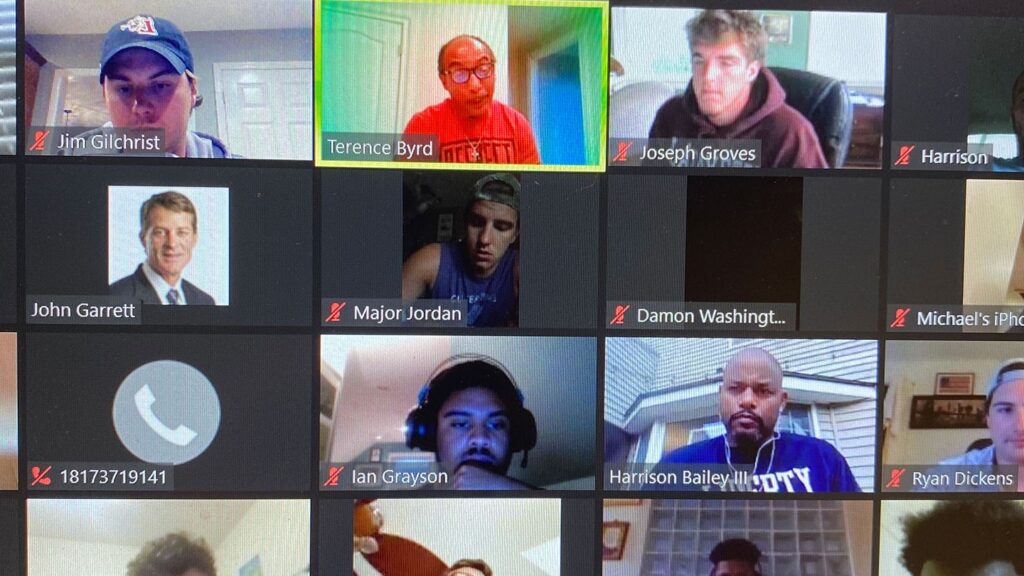Leading Equality
By Bryan Hay
Student-athletes are natural leaders and have an innate ability to effect change.

Terence Byrd ’74
That’s the message Terence Byrd ’74 and Harrison Bailey III ’95 brought to the current football team through an online conversation they organized earlier this year at the request of head football coach John Garrett.
Byrd and Bailey encouraged the team to leverage their leadership positions and collective social conscience to help make a difference in the areas of race and social justice.

Harrison Bailey III ’95
“If you want the campus to show more appreciation for equality, you can do that,” Bailey, a former captain of a championship Lafayette football team and now principal of Liberty High School in Bethlehem, Pa., said on the video.
“You can lead them in that direction. You can literally take it to the president,” Bailey said. “It’s amazing what you can accomplish if together you decide this is what we want and this is what we need. You have to put your collective brains together and go after what you want.”
In a recent interview, Byrd reminisced about his time at Lafayette 50 years ago and how that volatile era and those who sacrificed to achieve social reforms can help inform the desire for change today.

Byrd arrived at Lafayette in 1970 during a time of lingering pain from the murders in 1968 of the Rev. Dr. Martin Luther King Jr. and Robert F. Kennedy and the civil unrest that followed. But it was also a time of optimism as Lafayette welcomed women students to campus for the first time and admitted an increasing number of African American students.
Having the Black cultural center was recognition that Black students were on the campus
And it was right after the newly formed Association of Black Collegians (ABC) presented a list of demands to College President Roald Bergethon, including admitting more Black students, addressing racial attitudes on campus, creating more courses devoted to Black studies, and adding more Black faculty and administrators. Among the first results from ABC’s bold action was the establishment of the Black House. Originally on a corner of the Quad next to Hogg Hall, it was razed to make way for Farinon College Center and moved to its current location at 101 McCartney St.
“Having the Black cultural center was recognition that Black students were on the campus,” Byrd says.
“More Blacks matriculated in 1970, I believe there were 35 of us in the class, more than ever before. It was also the first year for women,” he adds. “So, we were part of that, part of a social change at the College. We came in as football players on the back of all this. We had to carry the message to educate fellow athletes and students across the campus. That was big for us.”
A two-year varsity starting and leading receiver on the football team and one of three Black students in the class recruited to play football at Lafayette, Byrd wants current students to understand that the desire to advocate for change is not something new. However, the power to achieve change remains as strong as ever, particularly among student-athletes.
“So, I thought these students needed to hear that,” Byrd says. “Because sometimes they might feel that maybe they’re looked down upon because they’re student-athletes. Because they are athletes, they really do not belong. And that is not the case. They are at the top of the class because of their academic and leadership abilities. They can make a positive change at the top.”
For some students, Lafayette College may provide their first encounter with African Americans. Student-athletes, particularly those of color, have an opportunity to show common bonds. “They’re getting to see up front and personal, in many ways, we’re not different,” Byrd says. “We all have similar emotions. We all have the same desire to achieve excellence and further our careers.”
Byrd has served in senior executive positions for several major health care organizations and now leads TLB Byrd & Associates, an advisory consulting firm for senior executives of national and regional managed care organizations. He points out that Black members of his graduating class, including the first women at Lafayette, went on to become CEOs, physicians, attorneys, and college presidents.
Another message he felt compelled to deliver was about “the greatest game that was never played,” the 1949 Sun Bowl.
When Lafayette received the invitation to play Texas College of Mines, now University of Texas at El Paso, Texas law prohibited Black players from playing on the same field as white players in a state-supported athletic event. Lafayette accepted the bid contingent upon being able to bring fullback David Showell ’51, a key Black player and former Tuskegee Airman who served in World War II.
When the Sun Bowl refused to relent on its decision, the president of Lafayette and students rallied around the team’s decision to boycott the game without Showell. Student outrage resulted in a hastily composed telegram sent to President Harry S. Truman from a Western Union office in downtown Easton.
Prescient and relevant to what’s happening today, the story still has the power to motivate and inspire, Byrd says.
“Now is not the time to be silent,” he says. “By going to Lafayette, it broadens your perspective, and how you think. And sometimes your sphere of influence becomes so much broader than the communities that you left. You may not be able to change their ways of thinking, but you’ll be able to change a much bigger audience by changing the world.”